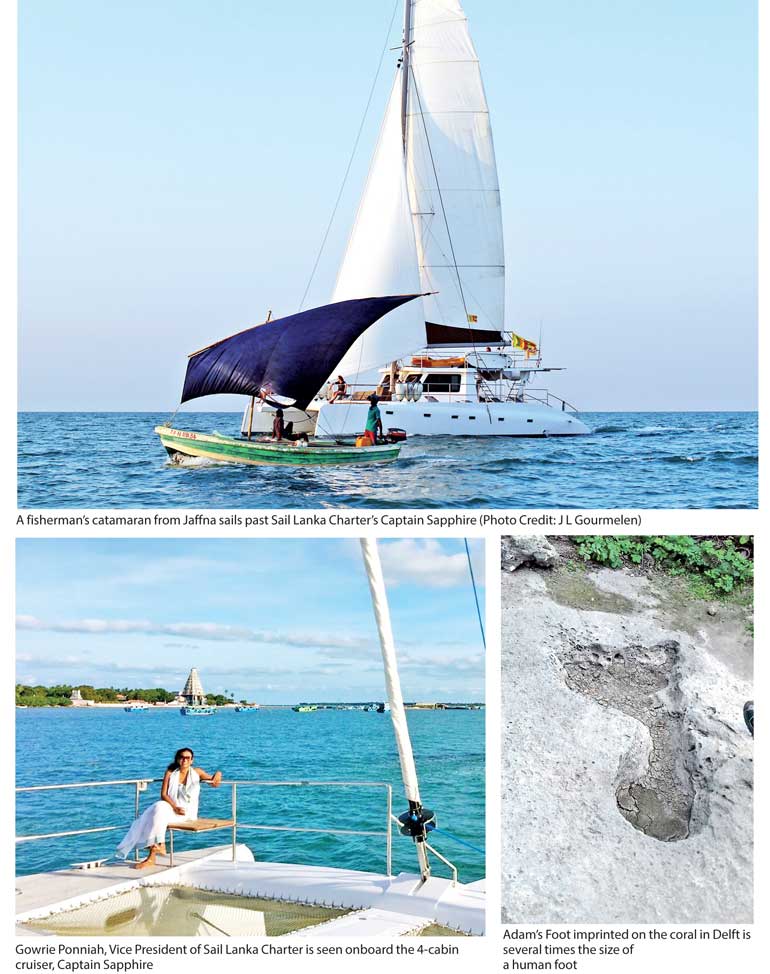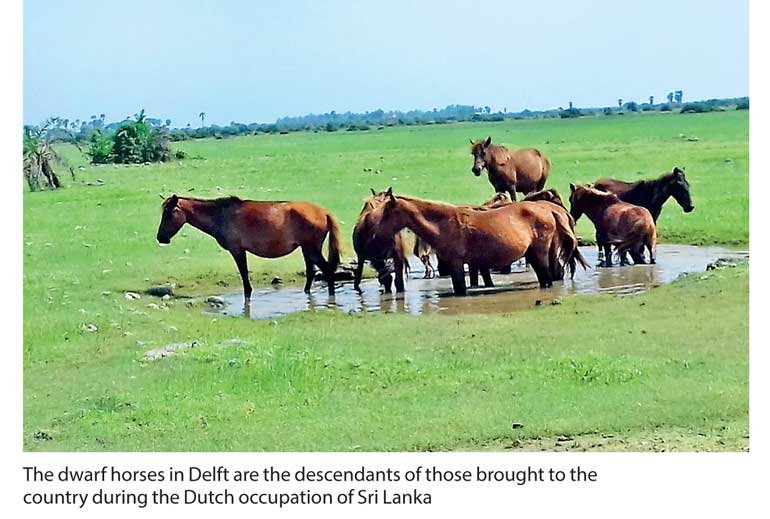Friday Nov 15, 2024
Friday Nov 15, 2024
Friday, 19 January 2018 00:00 - - {{hitsCtrl.values.hits}}

 By Ranjit J. Perera
By Ranjit J. Perera
An azure sea stretches into the distance and meets the blue sky at the horizon. It is a bright morning with a few white clouds above. The modern four-cabin cruiser sails along so smoothly that the welcome drink on the table on deck remains almost still.
Our destination is Delft, the largest of the islands off the coast of Jaffna and the furthest away. There is still some distance to go as we look back at the receding coastlines of Jaffna and the island of Nagadeepa.
Earlier, as we arrived on the jetty at Kurikadduwan for a 9 a.m. departure on a day-cruise, passengers were boarding a ferry to travel to Nagadeepa – Nainathivu as it is known in Tamil, where an ancient Buddhist shrine and a Hindu temple, draw devotees year-round. Kurikadduwan is situated on the island of Punguduthivu which is the furthest island connected to the Jaffna peninsula by a causeway and is about an hour’s drive from Jaffna town.
As we motored along, a vast expanse of water lay on either side of the causeway. An abundance of bird-life added to the beauty, as they went about choosing their breakfast. It is a particularly welcome scene, as at other times of the year all you see is a dry, barren land, marked with some shrubs.
Life-jackets are handed out and we are rowed across on a rubber dinghy to the #CaptainSapphire, a beautiful four-cabin cruiser one hundred metres away. It is a sleek white sail-boat built in Sri Lanka, and operated by Sail Lanka Charter, Sri Lanka’s premier yacht charter operator.
On the top deck, Captain Samitha peers into the distance as he steers the boat on a steady course to Delft. Crew members Tharindu and Samarasena adjust the sails as the inboard engine kicks-in to supplement the low winds.
Sitting across the table is Gowrie Ponniah, Vice President of Sail Lanka Charter, and she explains the philosophy of the founder of the company, Pierre Pringiers. “After pioneering the whale watching in Mirissa, he always wanted to make Sri Lanka the hub for yacht construction and yacht ownership and yacht chartering in the region, and to maximise the socio-economic benefits to the country by creating Sail Lanka Charter and the local yacht building yards, mini marinas and a training centre for all the skills required.
“Jaffna was the last destination because we have boats going out from Mirissa in the south, Beruwala in the west, and Trincomalee and Pasikudah in the east. The north of Sri Lanka is the only part of the country that has a number of islands which are totally suitable for sailing tourism and he felt that there was also something he could do to redevelop the post-war economy and bring a new type of tourism to the north.” “Beyond the tourism sector, our yachts offer an amazing experience and a new way for resident Sri Lankans and Sri Lankans residing overseas, to rediscover the country. The cruises in the northern islands, the day and overnight whale watching cruises from Mirissa and from Trincomalee, the morning and sunset cruises from Mirissa, Galle and Beruwala are all new, exciting and relaxing holiday opportunities.”
On the horizon, the island of Delft grows larger and larger. The sea is calm, although there was torrential rain in Jaffna the day before.
“Our yachts in Mirissa, Galle and Beruwela are also quite popular with both the young and the old, for weddings, pre-wedding parties and birthday parties. Whether it is only the sound of the wind or loud party music, both local and foreign guests enjoy the unique ambience on our purpose-built party boat.”
The unique hybrid, sail and engine powered catamaran yachts, cabin cruisers and day-cruisers are completely designed and built in Sri Lanka. With comfortable accommodation for eight passengers in four double-cabins and two double-crew quarters, each cabin has a western-style bathroom with toilet, shower and wash basin. The boats are equipped to provide the guests with freshly cooked food from the galley kitchen. Solar panels provide the 220V power for the galley refrigerators, lighting, WiFi, music system and water de-salinator. All yachts have a living cum dining area on the lower deck.“You only drop your bags onboard and you are home,” says Gowrie. “As you travel, you can choose whether to swim, snorkel, canoe, paddle-board or simply enjoy the incredible marine life. You can pour yourself a drink, enjoy the delicious food and fall asleep on deck with the cool breeze lapping your face.”
Speaking about the safety of the cruises Gowrie continues, “We have identified a number of safe anchoring points around the country, either protected bays or harbours and with the presence and cooperation of the navy and coast guard, we are operating in probably the safest waters in the world.”
The crew manoeuvre the yacht alongside the small jetty in Delft, and we go onshore for a tour of the island. The noonday heat doesn’t dampen our enthusiasm as the driver of the pickup truck deftly negotiates the dusty, bumpy tracks. The first feature in Delft that draws one’s attention is the parapet walls made by placing large bricks of dark coral one on top of the other. A visit to see Adam’s foot; a large footprint on the rock that is several times the size of a normal human footprint is a must on the tour. In this island of dead coral, we alight near a Hindu temple and are shown a live coral roughly shaped like the lingam that is venerated by people. As we move on, a herd of dwarf wild horses imported during the Dutch period frolic at a water-hole.
The giant Baobab tree believed to have been planted by Arab traders during the Portuguese rule provides welcome shade. Native to Africa and Arabia the tree is said to store water in the trunk to endure the harsh drought conditions. The ruins of what could have been an ancient stupa or temple, the Dutch courthouse and prison, the dovecote where the pigeons used by the Dutch to communicate were housed, are all worth exploring. Hungry after touring the island, we move into the restaurant nearby to have a tasty meal of rice with crab curry and fish.
We get on the boat for the return journey to Jaffna and decide to sail around the island of Delft as the sun dips towards the horizon. The stunning scenery makes me long for a good camera with a telephoto lens as I capture the moments with my mobile phone.
As we lounge on deck, the VP of Sail Lanka Charter explains more about the cruises to the islands near Jaffna, “Our day cruises, the overnight cruise to Delft, the two and three-nighters with a limited number of islands and the six-nighter where we take the guests all the way to Mannar and Talaimannar, are increasing in popularity, and encouraging us to expand our fleet in the north. We begin the journey from Kurikadduwan and go to Nagadeepa and then to Delft, Kakarativu, Annalativu and Iranativu. With permission from the Navy, we can take our guests up to Adam’s Bridge – the sand bank between Sri Lanka and India which we approach on a dinghy because the water is so shallow. As an option, we also organise a land tour of the Jaffna district, but with most of the guests, once they get on the boat, they don’t want to get off.”
I certainly would love to get onboard again and explore more of the islands of Jaffna.